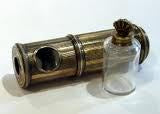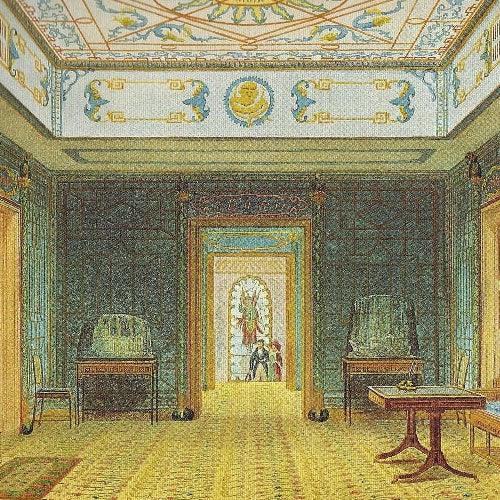Tambour Work
Tambour work was at least as popular as embroidery and was faster to produce. The fabric to be worked was stretched on a large frame held on a stand, and the lady used a hook like a tiny, sharp crochet hook to punch through the fabric and create a chain stitch. The result is almost indistinguishable from embroidered chain stitch except that it is so very fine and even, and the work goes more quickly. Tambour work is still used on couture clothing today. Fine muslins were perfect for tambouring because the loose weave was easy to punch through without damaging. Most work of the era was white-on-white; subtle, but the translucency of the muslin contrasted with the opacity of the tambouring. In addition to tambouring their dresses, fine ladies tamboured fichus (neckcloths), shawls (not very warm, but pretty), reticules, and more.
By the 1830's, machines had been created which could produce tambour work fabric 140 times faster than the average seamstress. Professional tambour artists were out of a job, and the ladies of leisure soon found other hand crafts to occupy their time and talents. Victorian tastes drifted away from the delicate details of the previous era and the art was virtually forgotten for a time.
 Netted lace fabric could be achieved in a similar fashion, as seen in this period fichu scarf. (image no longer available). In an era when white gowns were thought of as the height of fashion (after all, Northanger Abbey's Miss Tilney always wears white...) all white wedding gowns did not become di rigour until Queen Victoria's marriage in 1840. Until that point, colored gowns were as common as white for brides, and might even combine the two, as this period gown, found on Pinterest, demonstrates.
Netted lace fabric could be achieved in a similar fashion, as seen in this period fichu scarf. (image no longer available). In an era when white gowns were thought of as the height of fashion (after all, Northanger Abbey's Miss Tilney always wears white...) all white wedding gowns did not become di rigour until Queen Victoria's marriage in 1840. Until that point, colored gowns were as common as white for brides, and might even combine the two, as this period gown, found on Pinterest, demonstrates.

Jennie Chancey, owner of Sense and Sensibility Patterns has given kind permission to share these images taken during one of her Historical Fashion Tours of England. The gown shown here is part of the collection at the Victoria & Albert museum and offers an up close look at period tambour work. The V&A houses several tambour work gowns dating from 1795-1820. The gowns offer yet another way of incorporating the white on white effect so desired at the time; a look which indicated youth, innocence and even, perhaps, vulnerability.

Although the threads have yellowed over time, this contrast allows for closer inspection of the fine details in this beautiful dress, which was originally a white on white creation.


Of her abiding love for Regency history and fashion, Jennie writes,
"The first time I went to England was in 1988 as an Anglophile teenager in love with historical fashion. Given the choice to tour a castle or spend the entire afternoon sitting in the V&A's costume hall, I chose the latter! I happily sketched away, and I still have some of those original drawings I did of items I loved in the displays. When my husband took me back to England for our tenth anniversary in 2006, the V&A was on my "must see" list, as was the Museum of Costume in Bath. But, naturally, I also had to see Derbyshire, Chawton and Winchester to take in my fill of all things Jane. We just "happened" to be in Bath on the opening weekend of the 2006 Jane Austen Festival and enjoyed several costumed outings, tea in the Pump Room, and a tour of the Jane Austen Centre Museum. That trip was the springboard for the first group tour I led in 2009, and I've had the joy of introducing several dozen ladies to my favorite museums, private costume collections and "must-see" Austen sites in England for the past four years. The Jane Austen Centre has been a huge factor in the success of these tours with its well-organized yearly festival--particularly the annual Regency Costumed Promenade, which is the highlight of our trip each year. I'm already stitching madly for this September and look forward to seeing fellow Janeites in Bath!"Jennie is well known for her historically correct Regency (and other era) gown patterns, including the The Elegant Lady’s Closet ensemble. She also designed the Regency gown pattern sold by Simplicity.com. Her 2014 Historical Fashion Tour of England includes an all inclusive week of touring Liverpool, Manchester, Lacock, 3 private costume collections, as well as ample time to savor the delights of this year's Jane Austen Festival in Bath. Of special interest will be a full dress Titanic themed dinner. Visit the website for details on joining the this fabulous tour.



Leave a comment
This site is protected by hCaptcha and the hCaptcha Privacy Policy and Terms of Service apply.